Vivian Maier's instant popularity has something to do with the almost novelistic narrative detail of her photos, as well as the allure of her biography. Her work is on display at the Art Gallery of Hamilton until January 6, 2019.
By Mark Fenton
Published July 16, 2018
"You'll get one number and one number only 'cause I'm a lazy bastard. This is No Fun."
— Johnny Rotten, encore to the Sex Pistols final show, Winterland, San Francisco, 1978.

"This is No Fun." Like Abbott and Costello's "Who's on first" sketch, the trick hinges on a confusion of subject and description. He's telling us he's having no fun, and he's naming the song he's about to sing. The object is the description and the description is the object. Except that I'm pretty sure he is having fun messing with our heads. And if, like this writer, you're a fan of the band, the song is a good deal of fun. The statement is both ambiguation and erasure.
I've opened with this partly because I like its smoke and mirrors effect, but also because it showed me the way to approach the overabundance of great material in Vivian Maier: Street Photographer, on display at the Art Gallery of Hamilton until January 6, 2019. I don't think I'm being lazy but there's no way I could do justice to the whole show. So, you'll get one number and one number only and here it is.

Given her need for privacy, it's remarkable how often Vivian Maier photographed herself, and this uneasy mixture of exhibitionism and reticence is integral to her vision. Vivian lived so privately she kept a padlock on her room and showed no one her images. Yet daily she put herself out into the big city in strange garb, and she liked it when accidental mirrors provided a self-portrait.
Alfred Hitchcock appears in his work as a signature:

Alfred Hitchcock, Stage Fright, 1950
Woody Allen appears in his work as a main character:

Woody Allen, Manhattan, 1979
but in this photo Vivian Maier makes herself more than a signature (she's the largest figure in the shot) and less than a main character (she allows everyone else to upstage her, literally and metaphorically):

Much has been made of Vivian's frumpiness, with her house dresses and workboots (half a century before workboots were sexy on women) and incongrous hats. She was in fact a striking woman. The hat she's wearing was stylish in its day.
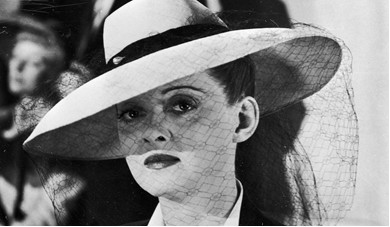
Betty Davis in Now Voyager, 1942
But where Bette Davis is so self-assured as to be almost combative, Vivian's downward gaze is tantalizing for being so hidden.

It would be fun to click on the image and make it be a video, like I can do with No Fun, and watch Vivian with her trademark mixture of disdain and disinterest and slyness - not unlike Johnny actually - look up and make eye-contact with me. But this is a microsecond snatched from eternity and will never be more. Most of her self-portraits reveal a woman looking directly at what the mirror shows her, and content. But not here. Here she leaves herself in the shadows, and this is just the beginning of the picture's ambiguity.
Her Rolleiflex demands looking downward into a diagonal viewfinder, ideal for the street photographer who wants to be incognito. It's the first mirror in a virtual hall of mirrors. Also, the Rolleiflex takes pictures that are exact squares, a geometric ideal that's perfect for the game she's playing with infinity.
Technically she's not shooting the two women looking into the shop - who are the subject of the photo to the extent that it has one - she's shooting the surface of a mirror that reflects them and reflects herself, creating two sets of (theoretically) infinite recurrences.
The 'selfie' section becomes its own picture. You can see her hat and dress falling away like a visual echo to viewer-left of Vivian.

The 'two women' section also becomes its own picture. But where Vivian's image moves downward to the dark corridors of her artistic vision (and oboy it was dark, but don't take my word for it, see the show and watch Charlie Siskel's excellent documentary)
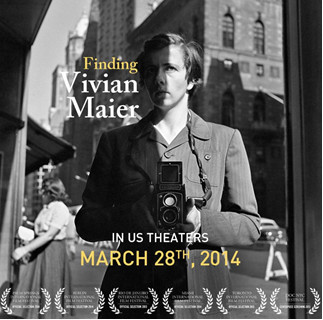
their's moves upward into the light.

Their second reflection can be isolated as a narrow rectangle so rich in subject matter it could be cropped and hung on its own.

The older woman is carrying a newspaper, which suggests working women rather than a mother and daughter gone out just to shop. They could have come from opposite directions and may not even know each other. Here, again, it would be nice if I could make it turn from a photo into a video as I can with No Fun, and that would be as good a title as any for the photo, given that these women look like they've been sent out shopping on Fifth Avenue at gunpoint.
I think that thing at the top of the rectangle is a neon sign, likely the name of the store they're looking into, probably not the lingerie store, but the next store south (I'll get to why I think we're looking south and why I think we're on Fifth Avenue). The sign is so forshortened we can't make out letters.

Coming as it does in the centre of the image, slightly towards the top, it feels like the central nervous system of the photo, distributing mental impulses that move the figures hither and thither.
Note the pair of men to the right of the pair of women. They contribute to the motif of doubling and recurrance, and they communicate depth of field by being dwarfed along the perspective line.

In real life I'm sure there was no connection between them. But artists love entangling couples for eternity, as with the many manacled enemies of Dante's Inferno.

Gustave Doré: Canto XXXII: Dante watching Ugoloini forever gnaw the skull of Ruggieri. This is unabiguously no fun.
The drama of the two men in question is less intense than the eternal vengeance of Ugo on Ruggi. Likely Vivian didn't even know these two men were in the shot. Write your own versions of the relationship. I have two.
In the first, the man in the hat is Alfred Hitchcock making his cameo in a frame from one of his films.
In the second, the one in the hat is a US agent gone bad, and the dark haired man is a Russian spy about to receive a handoff of microfiche in a plain, white business envelope and he won't even have to slow down at 51st Street because the light he's walking towards is green (see the album art for the 1957 Miles Davis album Walkin' for how I learned to read 50s NYC traffic lights even when they're in black and white).
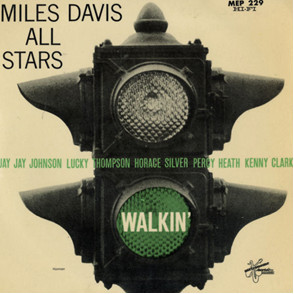
You expect the line of Vivians to converge with the line of the shoppers to a classic vanishing point. But they don't. Each set of recurrences has its own agenda. And neither connect with the vanishing point of the street, the tiny diagonal edge of the sidewalk half way up the left side of the photo square, whose zigzag creates a negative-space arrow that points

at the man in the white suit and the figures in front of him. In a movie they'd be extras, useful ones because their collective movement directs us to the 'real' vanishing point right. Or it would if the pedestrians weren't about to collide with a fortress of mirrors.
It's not quite a "what is it?" photo, but the shiftiness of the prestidigitator is at play. The mirrors make for a hard set of relationships to put together. At first I thought the items above Vivian's reflection were hats

which would be a nice echo of the hat she's wearing. But they're another reflection, turned five minutes clockwise, of the lingerie that we see in crisper focus over Vivian's left shoulder.

I just typed 'this is a very unVivian undergarment' but as soon as did I knew I was creating my own narrative of Vivian, her life, and her wardrobe and that's not responsible art criticism (How could I presume to know what's under her dress? What is wrong with me?) and if you could see me now you'd see a man slapping his left wrist with his right hand very hard, and then backspacing to obliterate all traces of his fecklessness.
The whole mess of regressing Vivians and the objects above them are a wormhole of infinity
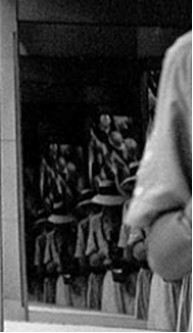
nicely framed by the wonky rectangle that makes it even more like a funhouse, where variations in the mirror plane and installation flaws are magnified by repetition. The result has the stop-motion effect of Duchamp's Muybridge inspired, Nu descendant un escalier no 2.

Untitled, Woman Walking Down a Plank,[detail], 1887, by Eadweard Muybridge; and Nude Descending a Staircase [No. 2], 1912, by Marcel Duchamp, Philadelphia Museum of Art
Seeing herself endlessly repeated in glass is also reminiscent of an Escher loop, E.G.: the man in a gallery viewing a picture of a city containing a gallery through whose window he sees himself viewing a picture of a city containing a gallery through whose window he sees himself....
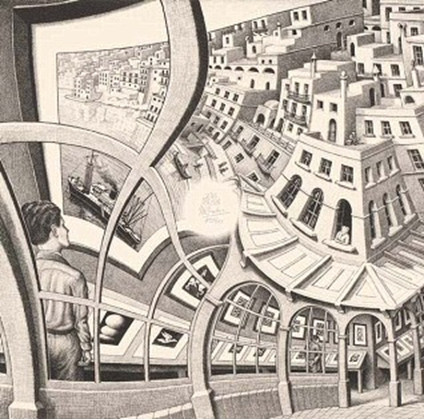
M.C. Escher, Print Gallery, 1956
and it reminds me of how, when I'm on hold for the pertinent Revenue Canada representative for what feels like eternity, I make what is no fun fun by doodling the Kolakoski sequence on my pad

(Google 'Kolakoski Sequence' if you don't know how this works but if you want to just trust me on this, it's another case where 'the description and thing described are identical.')
But what really rocks my world is how Vivian weds mathematical perfection to the messy realities of street life. As in the vertical strip in the centre of the picture which is the least definable section in terms of what it is and where it is in the real space of the street.

My best guess is that it's a diagonal mirrored corner of the shop entrance, and thus doesn't play into the mirror regression that dominates the photo. The cropped, headless body reveals a gloved hand. I can't even tell if it's a man's or a woman's. I'd like it to be the gloved hand of labourer, since then it becomes an allegorical figure sent by the gods of photography to hammer these fragments into the perfect square they become. It's the one piece of the puzzle I can't quite account for.
Because it predates Photoshop by half a century I don't believe it violates any laws of physics, something I can't quite claim for Las Meninas by Diego Velázquez whose masterpiece I'll dive into here as a companion to Vivian Maier's untitled masterpiece.
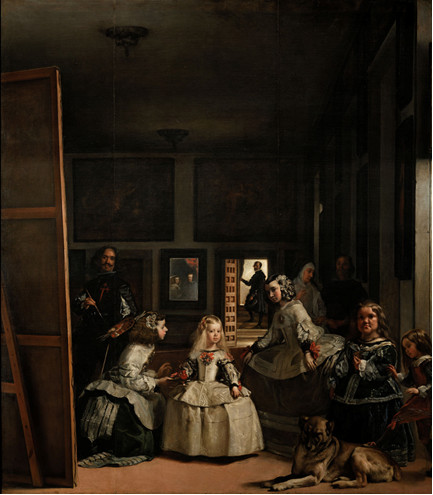
Diego depicts 11 people and a dog. Ignoring repetitions, Vivian's photo depicts 12 people and no dog, but post a correction if I'm mistaken. My math

makes that an equal number of mammals in both paintings (as well as turning visual art into an Olympic sport where Spain and the United States have just gone into sudden-death overtime).
Diego's picture contains a pair of dwarves. Vivian's contains a pair of men dwarfed by their distance from the camera. In neither picture are the people having fun, in fact a Marxist critic would say that the almost religious regard Diego's figures have for the monarchy correlates to the almost religious regard Vivian's window-shoppers have for conspicuous consumption. Both artists are not only in the picture but in the act of making the picture, yet neither is really the subject of the picture, which in Diego's case is the Infanta Margarita.
And both pictures are infinity loops. Diego must be looking into a mirror to paint this, as we can see the back of his canvas, something he wouldn't be able to see at all without a mirror.
So far so good. Until we find the second mirror. The beveling surrounding the vertical picture to the right of Diego tells us it's a mirror, not a painting, and any contemporary of Diego or historian of the Spanish renaissance will recognize the couple as King Philip IV and Queen Mariana.
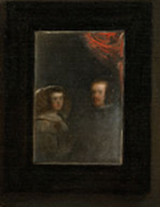
Likely they've just arrived in the room, since many of the figures, including their daughter, have turned to look at them with that mixture of awe, respect and trepidation that royalty inspires. But if they're standing where the mirror is, then the mirror isn't there. And if the mirror is there, then they aren't. If you want to give the situation some wiggle-room they could be standing in front of the mirror. But if so why aren't they repeated Vivianlike in the back mirror?
Here's why. If you draw perspective lines on a copy of the painting (please don't draw on the original) you find that the vanishing point is so far out of line with where the reflection falls that the royal couple couldn't be standing at our/Diego's-mirror POV, but that they must instead be a reflection of the canvas Diego is standing in front of. In other words, he's just painted a portrait of the king and queen as they stand in front of a reverent audience.
But then where does the scene we're looking at, this scene that Diego sees in a mirror and that even includes the back of a canvas he couldn't see without a mirror, come from? Is Diego cheating? Or do historians and art critics lack mirror expertise? I'd sure like to have Penn and Teller weigh in on this.
(Just to be clear, Las Meninas is in the Prado, Madrid and not on display at the AGH so don't complain to AGH staff that a review of Vivian Maier: Street Photographer made it look like Las Meninas was in the next room.)
Lastly, why do I think Vivian is shooting north into a mirror and thus giving us a view south? My only reference is the cathedral that looms over this vanitas of high-end, American-century retail.

My best guess is that it's St. Patrick's Cathedral at Fifth Avenue and 51st Street.)

St. Patrick's Cathedral, 1913
If I'm right, we're looking south and slightly east to its northwest corner. The problem is, I can't find an online photo that quite lines up with what we see here. If anyone knows NYC better than me, or Googles better than me, please post a correction.
I think Vivian Maier's instant popularity has something to do with the almost novelistic narrative detail of her photos, as well as the allure of her biography. She worked as a nanny and took her photos while carting other people's children all over Chicago and New York City. As a caregiver she was at best semi-engaged and at worst abusive.
She left roughly 150,000 (largely unprinted) negatives when she died and no one knew she'd taken them. Posthumously printed selections have already given her the status as a master of the medium. 'One number only' was as much as I could handle.
Get an AGH membership, go back every day, look closely at a different one each time, and write your own stories. And have fun.
By Deleais (registered) | Posted July 25, 2018 at 19:09:40
Wonderfullly intricate article by Mark F. as usual, enticing one into the entire Maier ouevre by discussing a single picture. Amazing. One quibble, Mark, the neon sign is likely one of those pullout arms that hold up awnings. Keep up the good work.
Comment edited by Deleais on 2018-07-25 19:10:08
By mfenton (registered) | Posted July 26, 2018 at 09:57:43
Thanks, Deleais, for the correction about the awning arm. Just before reading your comment a friend who grew up in NYC e-mailed me with the same correction (Oboy my face was neon-red!)so I think we can accept 'awning-arm' as meeting our collective agreement of what constitutes empirical truth. That’s the magic of photographic images: a microsecond to capture, an eternity to reconstruct.
You must be logged in to comment.
There are no upcoming events right now.
Why not post one?